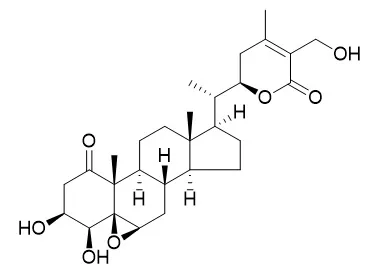| In vitro: |
| Tetrahedron, 2003, 59(6):841-849. | | Cyclooxygenase-2 inhibitory withanolides from Withania somnifera leaves.[Reference: WebLink] |
Four novel withanolide glycosides and a withanolide have been isolated from the leaves of Withania somnifera.
METHODS AND RESULTS:
The structures of the novel compounds were elucidated as physagulin D (1→6)-β-d-glucopyranosyl-(1→4)-β-d-glucopyranoside (1), 27-O-β-d-glucopyranosyl physagulin D (2), 27-O-β-d-glucopyranosyl Viscosalactone B (3), 4,16-dihydroxy-5β, 6β-epoxyphysagulin D (4), and 4-(1-hydroxy-2,2-dimethylcyclo-propanone)-2,3-dihydrowithaferin A (5) on the basis of 1D-, 2D NMR and MS spectral data. In addition, seven known withanolides withaferin A (6), 2,3-dihydrowithaferin A (7), Viscosalactone B (8), 27-desoxy-24,25-dihydrowithaferin A (9), sitoindoside IX (10), physagulin D (11), and withanoside IV (12) were isolated. These withanolides were assayed to determine their ability to inhibit cycloxygenase-1 (COX-1) and cyclooxygenase-2 (COX-2) enzymes and lipid peroxidation.
CONCLUSIONS:
The withanolides tested, except compound 9, showed selective COX-2 enzyme inhibition ranging from 9 to 40% at 100μg/ml. Compounds 4, 10 and 11 also inhibited lipid peroxidation by 40, 44 and 55%, respectively. The inhibition of COX-2 enzyme by withanolides is reported here for the first time. | | Life Sci. 2003 Nov 21;74(1):125-32. | | Growth inhibition of human tumor cell lines by withanolides from Withania somnifera leaves.[Pubmed: 14575818] | Ayurvedic medicines prepared in India consist of Withania somnifera roots as one of the main ingredients. It is consumed as a dietary supplement around the world. The leaves of W. somnifera were used in the treatment of tumors and inflammation in several Asian countries.
METHODS AND RESULTS:
We have isolated twelve withanolides such as withaferin A (1), sitoindoside IX (2), 4-(1-hydroxy-2, 2-dimethylcyclpropanone)-2, 3-dihydrowithaferin A (3), 2, 3-dihydrowithaferin A (4), 24, 25-dihydro-27-desoxywithaferin A (5), physagulin D (1-->6)-beta-D-glucopyranosyl- (1-->4)-beta-D-glucopyranoside (6), 27-O-beta-D-glucopyranosylphysagulin D (7), physagulin D (8), withanoside IV (9), and 27-O-beta-D-glucopyranosylViscosalactone B (10), 4, 16-dihydroxy-5beta, 6beta-epoxyphysagulin D (11), Viscosalactone B (12) from the leaves of this species. Compounds 1-12 and diacetylwithaferin A (13) were tested for their antiproliferative activity on NCI-H460 (Lung), HCT-116 (Colon), SF-268 (Central Nervous System; CNS and MCF-7 (Breast) human tumor cell lines.
The inhibitory concentration to afford 50% cell viability (IC50) for these compounds was determined by MTT (3-[4,5-dimethylthiazol-2-yl]-2,5-diphenyltetrazolium bromide) assay.
CONCLUSIONS:
Withaferin A and its derivatives exhibited inhibitory concentrations (50%) ranging from 0.24 +/- 0.01 to 11.6 +/- 1.9 microg/mL. Viscosalactone B (12) showed the 50% inhibition at concentrations ranging from 0.32 +/- 0.05 to 0.47 +/- 0.15 microg/mL whereas its 27-O-glucoside derivative (10) exhibited IC50 between 7.9 +/- 2.9 and 17.3 +/- 3.9 microg/ml. However, Physagulin D type withanolides showed either weak or no activity at 30 microg/mL. Therefore, incorporation of withanolides in the diet may prevent or decrease the growth of tumors in human. |
|






 Cell. 2018 Jan 11;172(1-2):249-261.e12. doi: 10.1016/j.cell.2017.12.019.IF=36.216(2019)
Cell. 2018 Jan 11;172(1-2):249-261.e12. doi: 10.1016/j.cell.2017.12.019.IF=36.216(2019) Cell Metab. 2020 Mar 3;31(3):534-548.e5. doi: 10.1016/j.cmet.2020.01.002.IF=22.415(2019)
Cell Metab. 2020 Mar 3;31(3):534-548.e5. doi: 10.1016/j.cmet.2020.01.002.IF=22.415(2019) Mol Cell. 2017 Nov 16;68(4):673-685.e6. doi: 10.1016/j.molcel.2017.10.022.IF=14.548(2019)
Mol Cell. 2017 Nov 16;68(4):673-685.e6. doi: 10.1016/j.molcel.2017.10.022.IF=14.548(2019)